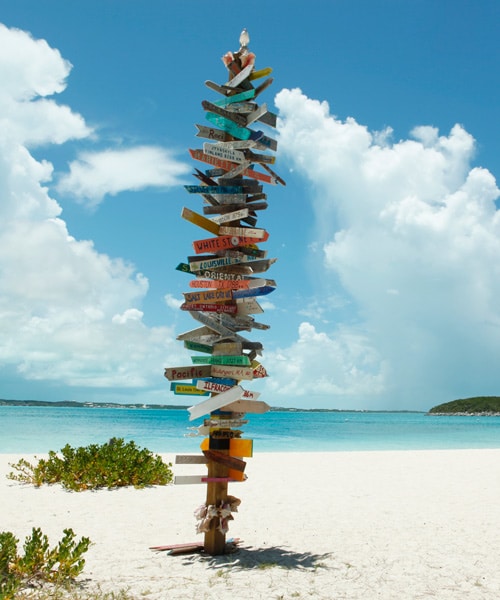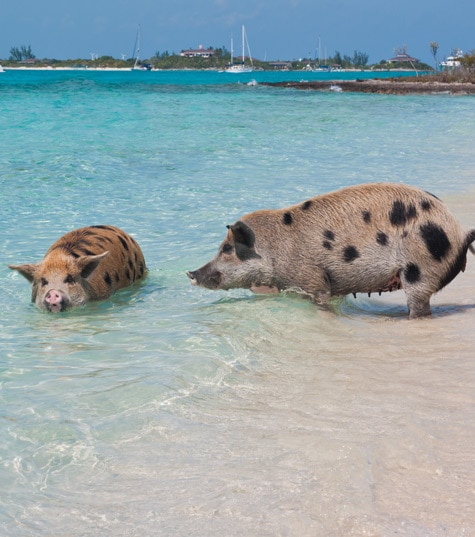Amy Hopkins sets sail for the Bahamas in search
of the Caribbean’s porkiest aquatic creatures

Getting up close with the friendly hogs in the shallows
‘Is that one?’ I lean eagerly over the side of the boat, squinting in the Caribbean sun and peering towards the tiny island ahead. I’m clutching a stubby can of Caribbean Kalik beer in one hand and my iPhone in the other, poised to capture my first glimpse of the creatures I’ve travelled 4,000 miles to meet. Not sharks, dolphins or turtles – I’m here to see pigs.
Swimming pigs have been the sole inhabitants of the Bahamian island of Big Major Cay for decades, but how they actually got there is something of a mystery. Local legend claims they swam ashore after a shipwreck, or were left on the island by sailors who planned to come back and eat them, but never did.
Big Major Cay is now the only place in the world where families swim with wild hogs. I’ve been pig-mad for as long as I can remember (my piggy-themed childhood bedroom was my pride and joy), and once I heard this modern-day fairytale, the Bahamas shot to the top of my bucket list.
My quest begins with a catamaran voyage from the port of Miami in the US. Two hours of cruising and several sick bags later (it’s a good idea to take some children’s seasickness tablets), I arrive on the sandy shore of North Bimini, the closest Bahamian island to the US and favourite getaway of Ernest Hemingway. The sea surrounding this small island is home to one of the best snorkelling spots in the Caribbean. It’s here that young imaginations are set racing by the shipwreck of steamship SS Sapona, which pokes above the water’s surface like the rib cage of an ancient whale.
I take a snorkelling boat trip with Bimini Undersea, departing from a jetty close to the Hilton, where I’m staying. I jump in with snorkel and flippers and lose track of time as I chase colourful fish among the Sapona’s sunbleached remains. Hours later, we cruise back to the harbour, lounging on deck, dozy from the day’s activities. To our delight, a pod of dolphins forms a motorcade around our boat, leaping high out of the water, just metres away. We’re even lucky enough to spot a flash of white underbelly as a stingray flings itself out of the sea.

Totally Shellfish – The chef at the Chat ‘N’ Chill conch shack
I had no idea that rays jump out of the water like that. Our captain tells us they do it to avoid becoming lunch for hammerhead sharks, but the kids on board are certain that the rays are just jumping for joy. A Bahamasair flight takes me from Bimini to an island seemingly untouched by the modern world, where the sand is footprint-free and locals farm and fish as their ancestors have done for generations.
This is Great Exuma, one the Bahama’s precious Out Islands, where thankfully cruise ships struggle to dock. It’s here that I meet Skeeter Dean, a 90-year-old taxi driver who doesn’t consider himself in the least remarkable. ‘People in the Out Islands regularly live to over 100,’ he tells me. ‘What’s their secret?’ I want to know. Skeeter flashes me a toothless grin and gestures to the crops growing in the field beside us: ‘They grow they own, and they eat they own!’
I get a memorable taste of this life-prolonging island diet when I take a water taxi from Great Exuma to Stocking Island, home of the legendary Chat ‘N’ Chill beach bar. Chat ‘N’ Chill has been owned by laidback local Ken ‘KB’ Bawe for nearly 20 years and his relaxed vibe is a magnet to tourists.
With your toes in the sand, you’ll tuck into grilled fish, peas’n’rice (not to be confused with Jamaican rice’n’peas, which has more rice and fewer peas) and KB’s legendary garlic cabbage slaw. Just don’t be in a hurry to receive your food. It’s all cooked fresh, and service runs on Caribbean time.
At the water’s edge is the Chat ‘N’ Chill conch shack. Conch is a mollusc in a coral-pink spiralled shell (kids studying Lord Of The Flies will recognise it immediately), and it’s the hero of Bahamian cuisine. Whichever of the 16 islands you visit, you’ll eat it by the bucketload. Down at the conch shack, I watch with grim fascination as KB’s chef selects a shell from the pile on the beach, knocks a hole in the end, inserts his finger and pulls out a slimy, black conch.

Every which way – a very thorough signpost at the beach on Stocking Island
I’ve spent days cheerfully stuffing my face with conch, in all its guises (conch salad, conch fritters, conch burger, cracked conch…) and it’s disturbing to finally come face to face with one – not least because it has cartoonishly cute eyes on the end of stalks. The chef makes quick work of dicing the mollusc with his machete, adding tomatoes, lime and jalapeno peppers, before handing me with a delicious heap of conch salad.
It turns out I’m not the only one lunching at the conch shack that day. As I paddle in the sea beside the hut, I spot four shadows rippling through the water towards me, menacing spear-like tails trailing behind them.
It’s a fever of stingray (to give rays their gorgeous collective noun) who regularly swim close to the beach on Stocking Island to feast on discarded conch. At first, I’m unnerved (Steve Irwin suddenly sprung to mind) and want to retreat to the shore, but once the rays reach me, I’m touched by how gentle these prehistoric creatures are.
They circle me, raising their wing-like sides and lapping at my legs, their bodies feeling weirdly muscular and soft. I hold a sliver of conch just below the water’s surface and the biggest ray, probably 2m long, soars over my outstretched hand. I can’t see his mouth on the underside of his body, but I feel a gentle scratch as his mouth makes contact with the conch on my palm.

Bigger than expected! A swimming pig
On the last afternoon of my holiday, I set sail, finally, for Big Major Cay, the home of the swimming pigs. I set off on an Exuma Water Sports boat tour, with ten or so other holidaymakers. A few metres from the shore of Big Major Cay, the powerboat slows. By now, everyone has cameras gripped in hands, GoPros strapped to heads (or both), and the kids are hopping up and down with anticipation. ‘Pebbles!’ our guide calls towards the island in a smooth Caribbean accent, his hands cupped around his mouth. ‘Yoo-hoo! Peb-bles!’
Before long, his call is answered and we spot a ginger pig paddling keenly towards us, snout aloft and twitching, his trotters moving rapidly underwater. He’s surprisingly elegant for a pig and, I realise as he draws closer – he’s huge! Google ‘swimming pigs’ and you’ll find photos of pouting bikini models crouching beside adorable pink piglets on the beach. But Pebbles is a big bristly hog with crooked teeth sticking out of his salivating mouth.
Even though Pebbles’ head is the size of my torso, the kids don’t hesitate in jumping into the waist-deep water and wading towards him. Following their lead, I approach cautiously. Pebbles gives me a gentle shove with his snout. He tips back his vast head and opens his triangular mouth, into which I drop one of the turkey frankfurters provided by the tour guides.
Soon, Pebbles is joined by half-a-dozen of his pals – black, ginger and pink. We splash about with them, scratching the happy hogs behind their twitching ears and depositing frankfurter after frankfurter into their waiting mouths.
Of all the creatures you’ll meet in the Bahamian seas, these pigs are easily the least exotic – yet somehow, they are the most special. Thanks to their social-media fame, the pigs are becoming so popular that tourists might soon be prevented from feeding them. But just watching them from a boat with the kids will still be a joyful experience. After all, the Bahamas’ swimming pigs are the stuff fairytales are made of.

A dream realised: Meeting the pigs
When to go
December-April is best, when it’s dry and temperatures are around 26-28C. Note, this is peak season, when hotel rates are at their highest. The summer months are humid and very hot.
How to get there
Direct return flights from London to Nassau (the main Bahamian island) with British Airways start at £750pp during the Christmas holidays. Flight time is 9 hours.
Alternatively, direct flights from London Gatwick to Miami during the Christmas holidays start at £490pp with Norwegian. From Miami, catch the 8am FRS-Caribbean ferry to Bimini. During high season, a one-way ticket costs £113 for adults and £81 for children.
Where to stay
On North Bimini, stay at Hilton at Resorts World, where rooms start at £140 a night in high season. On Great Exuma, for a treat, stay at Grand Isle Resort & Spa on Emerald Bay, where private luxury villas start at £300 per night in high season.